Citric Acid Cycle / Krebs Cycle / Tricarboxylic Acid Cycle
1/25
Earn XP
Description and Tags
Session 14
Name | Mastery | Learn | Test | Matching | Spaced |
|---|
No study sessions yet.
26 Terms
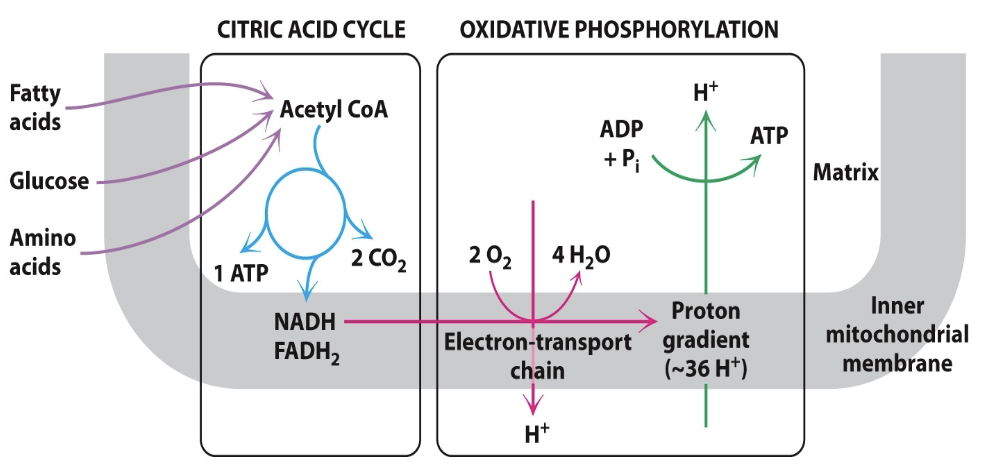
What is described in the following image and points:
Process in which cells consume O2 and produce CO
Provides energy (ATP) from glucose (more than than glycolysis)
Can capture energy stored in lipids and amino acids
Evolutionary origin: developed about 2.5 billion years ago
Used by animals, plants, and many microorganisms
Citric Acid Cycle + Oxidative Phosphorylation
Occurs in three major stages:
Acetyl CoA production
Acetyl CoA oxidation
Electron transfer and oxidative phosphorylation
Cellular Respiration
The pyruvate dehydrogenase complex includes 3 types of enzymes that collectively remove a carboxylate group from pyruvate and produce what two molecules?
Acetyl-CoA and NADH

Under aerobic conditions, pyruvate is transported into _________ membrane where it is oxidatively decarboxylated by pyruvate dehydrogenase complex to form Acetyl-CoA
mitochondrial
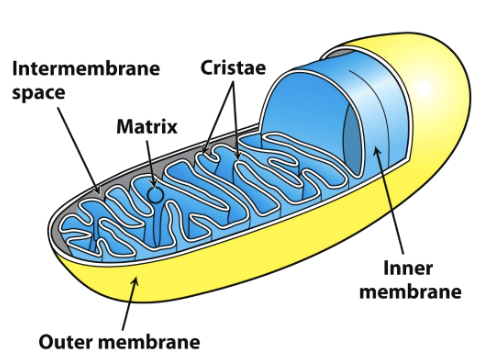
Pyruvate Dehydrogenase Complex Mechanism: the synthesis of Acetyl-CoA from pyruvate requires 3 enzymes and 5 coenzymes. What are the 3 main steps?
Decarboxylation
Oxidation
Transfer of acetyl group to CoA to form Acetyl-CoA

What are the 5 coenzymes of pyruvate dehydrogenase reaction?
Catalytic cofactors (3) - capable of catalyzing multiple reactions
Thiamine pyrophosphate (TPP)
Lipoic acid
FAD
Stoichiometric cofactors (2) - 1 to 1 ratio; one cofactor is needed for one reaction
CoA
NAD+
What are the 3 enzymes of pyruvate dehydrogenase complex?
Pyruvate dehydrogenase (E1)
Dihydrolipoyl transacetylase (E2)
Dihydrolipoyl dehydrogenase (E3)

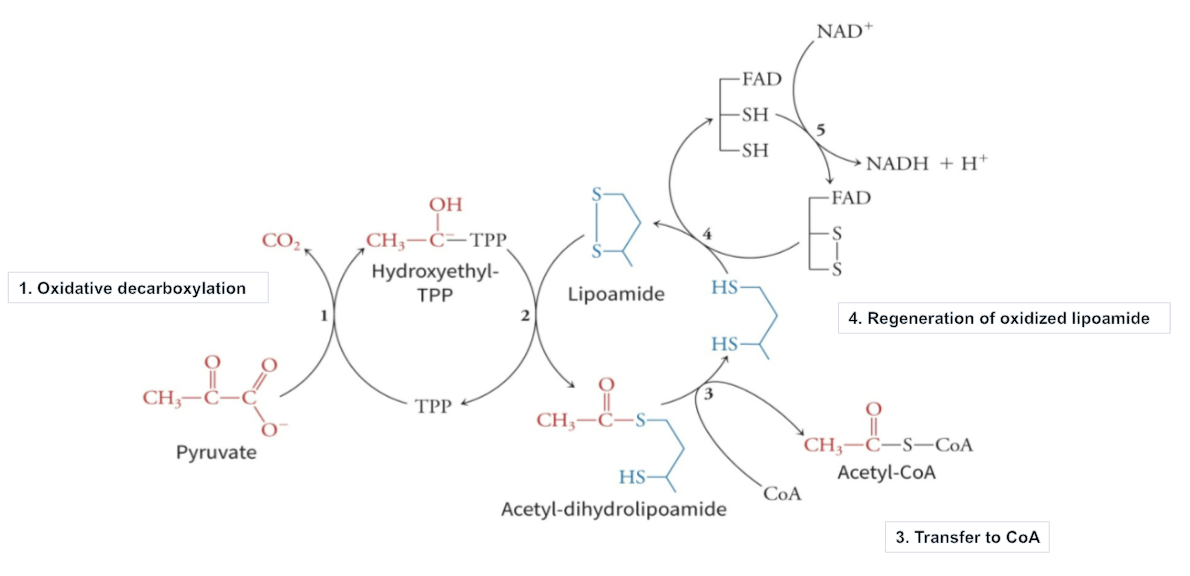
What is described in the following image?
Summary of the Pyruvate Dehydrogenase Reactions
What is being described by the following points:
Pyruvate + CoA + NAD+ → Acetyl-CoA + CO2 + NADH + H+
Irreversible reaction
Link between glycolysis and the citric acid cycle
Captures high-transfer-potential electrons in the form of NADH
Pyruvate dehydrogenase complex

What is described by the following points:
The central metabolic hub of the cell
The final common pathway for the oxidation of fuel molecules
Important source of precursors for the building blocks of many biomolecules
Ex. amino acids, fatty acids, nucleotide bases, and porphyrins
Series of oxidation-reduction reactions that result in the oxidation of an acetyl group to 2 CO2 molecules
Eight reactions
An acetyl group is condensed with oxaloacetate
2 CO2 are lost
Oxaloacetate is regenerated
Each round generates 3 NADH, 1 FADH2, and 1 GTP or ATP
Flux through the citric acid cycle regulated primarily by feedback inhibition at 3 steps
Citric Acid Cycle, Tricarboxylic Acid Cycle (TCA) or Krebs cycle
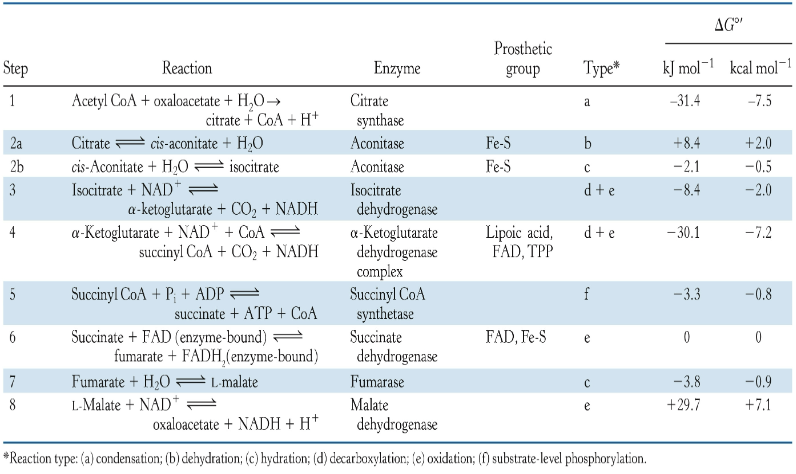
What is described by the following points:
Harvests high-energy electrons from carbon fuels
These electrons will be used to power the synthesis of ATP
Cellular respiration provides the vast preponderance of energy used by aerobic cells
>90% in humans
Overview of the Citric Acid Cycle
The Citric Acid Cycle takes place in the ________ of the mitrochondria
matrix
Explain Step 1 of the Citric Acid Cycle
Enzyme: Citrate Synthase
Aldol condensation + hydrolysis
Condenses oxaloacetate (a 4C unit) and acetyl (a 2C unit) group of acetyl-CoA
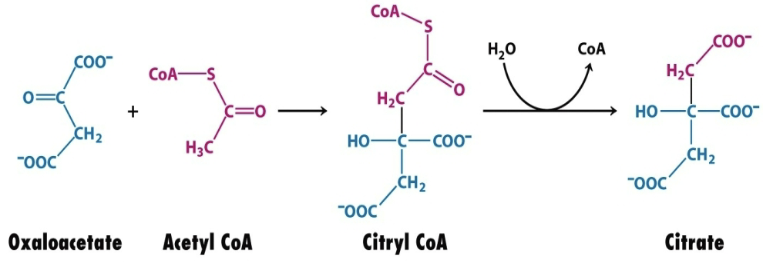
Explain Step 2 of the Citric Acid Cycle
Enzyme: Aconitase
Dehydration + hydration
Citrate is isomerized into isocitrate to enable the 6C unit to undergo oxidative decarboxylation

Explain Step 3 of the Citric Acid Cycle
Enzyme: Isocitrate dehydrogenase
Oxidative decarboxylation of isocitrate → α-ketoglutarate
Isocitrate + NAD+ → α-ketoglutarate + CO2 + NADH

Explain Step 4 of the Citric Acid Cycle
α-ketoglutarate dehydrogenase complex
2nd oxidative decarboxylation
Homologous to the pyruvate dehydrogenase complex
Pyruvate + CoA + NAD+ → Acetyl-CoA + CO2 + NADH
α-ketoglutarate + NAD+ → Succinyl CoA + CO2 + NADH


Explain Step 5 of the Citric Acid Cycle
Enzyme: Succinyl CoA Synthetase (Succinate Thiokinase)
Cleavage of the thioester bond of succinyl CoA is coupled to the phosphorylation of an ADP
Example of substrate-level phosphorylation because succinyl phosphate, a high phosphoryl-transfer potential compound, donates a phosphate to ADP
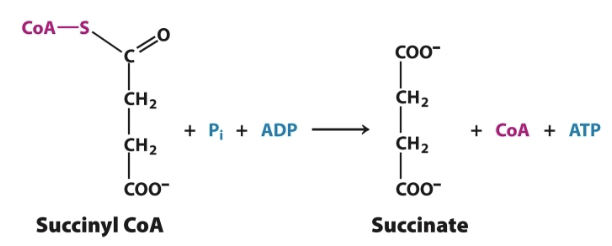
Explain Step 6-8 of the Citric Acid Cycle
Reactions of four-carbon compounds constitute the final stage of the CAC: the regeneration of oxaloacetate
Succinate → Fumarate → Malate → Oxaloacetate


What is shown in the following image?
The Citric Acid Cycle
Step, Reaction, Enzyme, Prosthetic Group, Type (condensation, dehydration, hydration, decarboxylate, oxidation, substrate-level phosphorylation), and Gibbs free energy
What is the net reaction for the Citric Acid Cycle?
Acetyl CoA + 3NAD+ + FAD + ADP + Pi + 2H2O → 2CO2 + 3NADH + FADH2 + ATP + 2H+ + CoA
The citric acid cycle is an energy-______ cycle
generating
1 NADH = 2.5 ATP
1 FADH2 = 1.5 ATP
~32 ATP per glucose

How is the pyruvate dehydrogenase complex regulated?
Allosterically
By reversible phosphorylation
Pyruvate → Acetyl-CoA is irreversible in animal cells
Acetyl-CoA has 2 principle fates:
Metabolism by the citric acid cycle
Incorporation into fatty acids
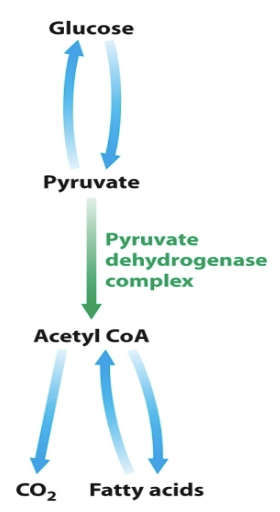
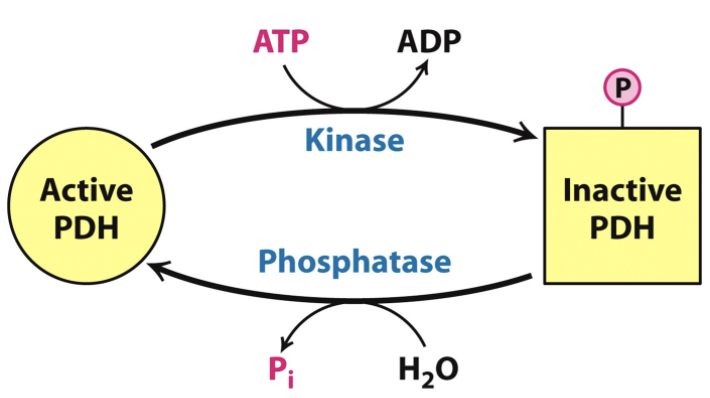
Regulation of Pyruvate Dehydrogenase
Product inhibition by NADH and Acetyl-CoA
Covalent modification of E1 (phosphorylation) → inactivation
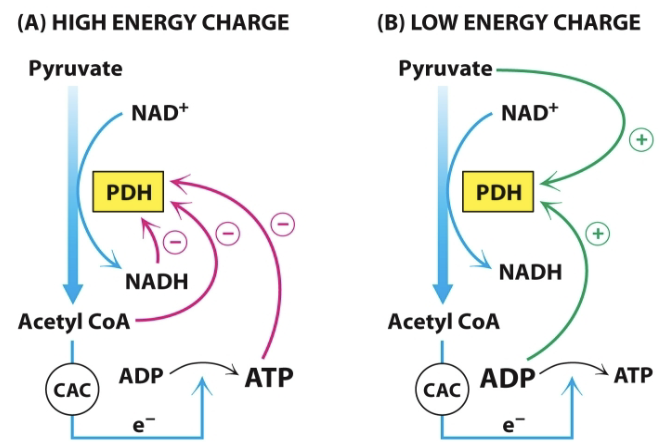
Regulation of Citric Acid Cycle
Substrate Availability
Acetyl-CoA and Oxaloacetate
Product Inhibition
ATP, NADH, citrate…
Competitive Feedback succinyl-CoA
Key control points
The reactions catalyzed by isocitrate dehydrogenase and α-ketoglutarate dehydrogenase
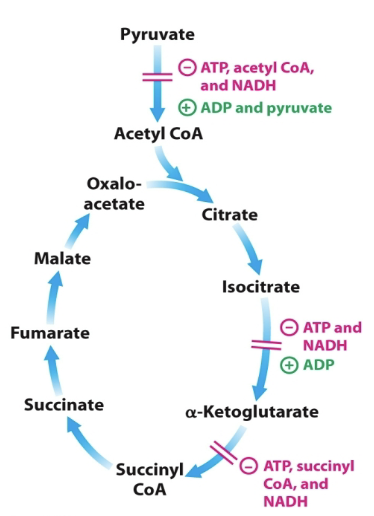
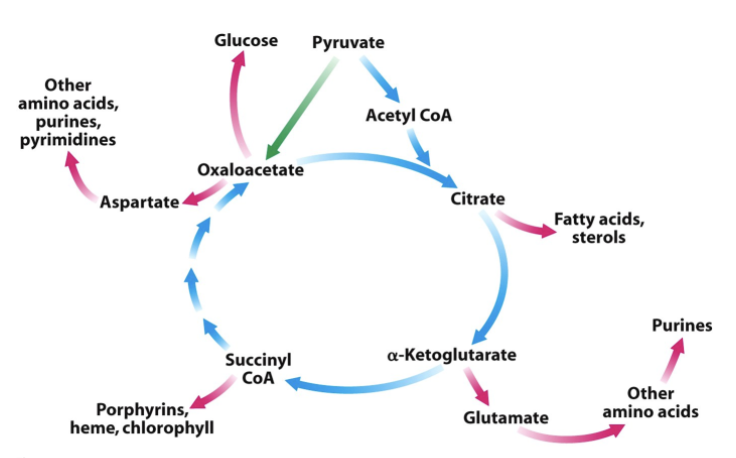
What is described by the following points:
Supplies precursors for the synthesis of other compounds (catabolic; cataplerotic reaction)
Intermediates are precursors of other molecules
Intermediates can be replenished (anabolic; anaplerotic reaction)
Mammals lack the enzymes for the net conversion of acetyl-CoA → oxaloacetate or any other CAC intermediates
Oxaloacetate is formed by the carboxylation of pyruvate
Amphibolic Functions of the Citric Acid Cycle
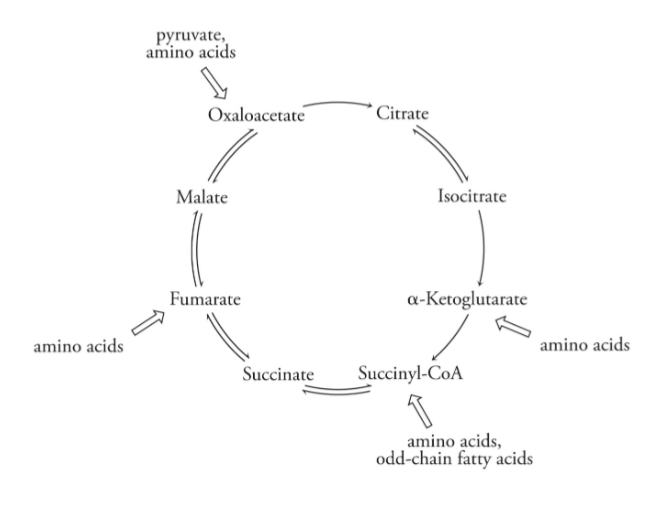

What is shown in the following image?
Example of a cataplerotic Citric Acid Cycle reaction
α-ketoglutarate (TCA intermediate) → Glutamate (amino acid)
Glutamate is a precursor of the amino acids glutamine, arginine, and proline

What type of reaction is the following:
Pyruvate + CO2 + ATP + H2O → Oxaloacetate + ADP + Pi
Anaplerotic reaction to replenish Citric Acid Cycle intermediates